欢迎来到相识电子书!
标签:郑和
-
1434
One thing that greatly puzzled me when writing 1421 was the lack of curiosity among many professional historians. After all, Christopher Columbus supposedly discovered America in 1492. Yet 18 years before he set sail, Columbus had a map of the Americas, which he later acknowledged in his logs. Indeed, even before his first voyage, Columbus signed a contract with the King and Queen of Spain that appointed him Viceroy of the Americas. His fellow ship’s captain, Pinzon, who sailed with him in 1492 had too seen a map of the Americas -- in the Pope’s library. How do you discover a place for which you already have a map? The same question could be asked of Magellan. The straits that connect the Atlantic to the Pacific bear the great Portuguese explorer’s name. When Magellan reached those straits, he had run out of food and his sailors were reduced to eating rats. Worse, they were convinced they were lost. Esteban Gomez led a mutiny, seizing the San Antonio with the intent to lead part of the expedition back to Spain. Magellan quashed the mutiny by claiming he was not at all lost. A member of the crew wrote , "We all believed that [the Strait] was a cul-de-sac; but the Captain knew that he had to navigate through a very well concealed strait, having seen it in a chart preserved in the treasury of the King of Portugal, and made by Martin of Bohemia, a man of great parts." Why were the straits named after Magellan when Magellan had seen them on a chart before he set sail? Once again, it doesn’t make sense. The paradox might be explained had there been no maps of the straits or of the Pacific – if, as some believe, Magellan was bluffing about having seen a chart. But there were maps. Waldseemueller published his map of the Americas and the Pacific in 1507, thirteen years before Magellan set sail. In 1515, four years before Magellan sailed, Schoener published a map showing the straits Magellan is said to have "discovered." The great European explorers were brave and determined men. But they discovered nothing. Magellan was not the first to circumnavigate the globe nor was Columbus the first to discover the Americas So why, we may ask, do historians persist in propagating this fantasy? Why is the "Times History of Exploration," which details the discoveries of European explorers, still taught in schools? Why are the young so insistently misled? After 1421 was published, we set up our website, www.1421.tv, which has since received millions of visitors. Additionally we have received hundreds of thousands of emails from readers of 1421, many bringing new evidence to our attention. Of the criticism we’ve also received, the most frequent complaint has concerned my failure to describe the Chinese fleets’ visits to Europe when the Renaissance was just getting underway. Two years ago, a Chinese Canadian scholar, Tai Peng Wang, discovered Chinese and Italian records showing beyond a doubt that Chinese delegations had reached Italy during the reigns of Zhu Di (1403 – 1425) and the Xuande Emperor (1426 – 1435). Naturally, this was of the greatest interest to me and the 1421 team. Shortly after Tai Peng Wang’s 2005 discovery, Marcella and I set off with friends for Spain. For a decade, we’ve enjoyed holidays with this same group of friends, travelling to seemingly inaccessible places – crossing the Andes, Himalayas and Hindu Kush, voyaging down the Amazon, journeying to the glaciers of Patagonia and to the High Altiplano of Bolivia. In 2005 we walked the Via de la Plata from Seville, from which the Conquistadores sailed to the New World, north to their homeland of Extremadura. Along the way, we visited the towns in which the Conquistadores were born and grew up. One of these was Toledo, painted with such bravura by El Greco. Of particular interest to me were the mediaeval pumps by which this fortified mountain town drew its water from the river far below. On a lovely autumn day, we walked uphill to the great cathedral that dominates Toledo and the surrounding countryside. We dumped our bags in a small hotel built into the cathedral walls and set off to explore. In a neighbouring Moorish palace there was an exhibition dedicated to Leonardo da Vinci and his Madrid codices, focusing on Leonardo’s pumps, aqueducts, locks and canals -- all highly relevant to Toledo. The exhibit contained this note: "Leonardo embarked upon a thorough analysis of waterways. The encounter with Francesco di Giorgio in Pavia in 1490 was a decisive moment in Leonardo’s training, a turning point. Leonardo planned to write a treatise on water." This note puzzled me. I had been taught that Leonardo had designed the first European canals and locks, that he was the first to illustrate pumps and fountains. So what relevant training had he received from di Giorgio, a name completely unknown to me? My research revealed that Leonardo had owned a copy of di Giorgio’s treatise on civil and military machines. In the treatise, di Giorgio had illustrated and described a range of astonishing machines, many of which Leonardo subsequently reproduced in three-dimensional drawings. The illustrations were not limited to canals, locks and pumps; they included parachutes, submersibles tanks and machine guns as well as hundreds of other machines with civil and military applications. This was quite a shock. It seemed Leonardo was more illustrator than inventor and that the greater genius may have resided in di Giorgio. Was di Giorgio the original inventor of these fantastic machines? Or did he, in turn, copy them from another? I learned that di Giorgio had inherited notebooks and treatises from another Italian, Mario di Jacopo ditto Taccola (called Taccola "the jackdaw"). Taccola was a clerk of public works living in Siena. Having never seen the sea or fought a battle, he nevertheless managed to draw a wide variety of nautical machines – paddle wheeled boats, frogmen and machines for lifting wrecks together with a range of gunpowder weapons, even an advanced method of making gunpowder. It seems Taccola was responsible for nearly every technical illustration that di Giorgio and Leonardo had later improved upon. So, once again, we confront our familiar puzzle: How did a clerk in a remote Italian hill town, a man who had never travelled abroad nor obtained a university education, come to produce technical illustrations of such amazing machines? This book attempts to answer that and a few related riddles. In doing so, we stumble upon the map of the Americas that Taccola’s contemporary, Paolo Toscanelli, sent to both Christopher Columbus and the King of Portugal, in whose library Magellan encountered it. Like 1421, this book is a collective endeavour that never would have been written without the help of thousands of people across the world. I do not claim definitive answers to every riddle. This is a work in progress. Indeed, I hope the reader will join us in the search for answers and share them with us – as so many did in response to 1421. However, before we meet the Chinese squadron upon its arrival in Venice and then Florence, a bit of background is necessary on the aims of the Xuande Emperor for whom Grand Eunuch Zheng He served as ambassador to Europe. A Xuande imperial order dated 29th June 1430 stated: "The New Reign of Xuan De has commenced and everything shall begin anew. But distant lands beyond the seas have not yet been informed. I send Eunuchs Zheng He and Wang Zing Hong with this imperial order to instruct these countries to follow the way of heaven with reverence and to watch over their people so that all might enjoy the good fortune of lasting peace." The first three chapters of this book describe the two years of preparations in China and Indonesia to fulfil that order, which required launching and provisioning the greatest fleet the world had ever seen for a voyage across the world. Chapter 4 explains how the Chinese calculated longitude without clocks and latitude without sextants –prerequisites for drawing accurate maps of new lands. Chapters 5 and 6 describe how the fleet left the Malabar Coast of India, sailed to the canal linking the Nile to the Red Sea, then down the Nile into the Mediterranean. Some have argued that no Chinese records exist to suggest Zheng He’s fleets ever left the Indian Ocean. Chapters 5 and 6 document the many records in China, Egypt, Dalmatia, Venice, Florence and the Papacy describing the fleets’ voyage. In Chapter 21, I discuss the immense transfer of knowledge that took place in 1434 between China and Europe. This knowledge originated with a people who, over a thousand years, had created an advanced civilisation in Asia; it was given to Europe just as she was emerging from a millennium of stagnation following the fall of the Roman Empire. The Renaissance has traditionally been portrayed as a rebirth of the classical civilisations of Greece and Rome. It seems to me the time has come to reappraise this Eurocentric view of history. While the ideals of Greece and Rome played an important role in the Renaissance, I submit that the transfer of Chinese intellectual capital to Europe was the spark that set the Renaissance ablaze. When you have read the book, please tell us whether you agree. Synopsis In his bestselling book 1421:The Year China Discovered the World, Gavin Menzies revealed that it was the Chinese that discovered America, not Columbus. Now he presents further astonishing evidence that it was also Chinese advances in science, art, and technology that formed the basis of the European Renaissance and our modern world. In his bestselling book 1421: The Year China Discovered the World, Gavin Menzies presented controversial and compelling evidence that Chinese fleets beat Columbus, Cook and Magellan to the New World. But his research has led him to astonishing new discoveries that Chinese influence on Western culture didn't stop there. Until now, scholars have considered that the Italian Renaissance - the basis of our modern Western world - came about as a result of a re-examining the ideas of classical Greece and Rome. However, a stunning reappraisal of history is about to be published. Gavin Menzies makes the startling argument that a sophisticated Chinese delegation visited Italy in 1434, sparked the Renaissance, and forever changed the course of Western civilization.After that date the authority of Aristotle and Ptolemy was overturned and artistic conventions challenged, as was Arabic astronomy and cartography. Florence and Venice of the 15th century attracted traders from across the world. Menzies presents astonishing evidence that a large Chinese fleet, official ambassadors of the Emperor, arrived in Tuscany in 1434 where they met with Pope Eugenius IV in Florence. A mass of information was offered by the Chinese delegation to the Pope and his entourage - concerning world maps (which Menzies argues were later given to Columbus), astronomy, mathematics, art, printing, architecture, steel manufacture, civil engineering, military machines, surveying, cartography, genetics, and more. It was this gift of knowledge that sparked the inventiveness of the Renaissance - Da Vinci's inventions, the Copernican revolution, Galileo, etc. Following 1434, Europeans embraced Chinese intellectual ideas, discoveries, and inventions, which formed the basis of European civilization just as much as Greek thought and Roman law. In short, China provided the spark that set the Renaissance ablaze. -
明钞本《瀛涯胜览》校注
郑和下西洋,是明朝初年一大盛事,也是中国乃至世界航海上规模最大,持续时间最长,影响最深远的航海活动。然而,下西洋档案没有完整的保留下来,郑和本身又没有什么著述,今人所见下西洋原始资料中最重要的一部,即马欢《瀛涯胜览》,顾名思义就是海外游记。他的这部海外记录,具有丰富内涵,让更多世人了解下西洋的盛事,描述了世人鲜为人知的海外世界。 现存郑和下西洋三部基本文献,包括马欢《瀛涯胜览》、费信《星槎胜览》、巩珍《西洋番国志》,都是当时跟随下西洋的人所著。其中,马欢《瀛涯胜览》一书,出自亲历下西洋的通事(即翻译)之手,更具原始资料性质,弥足珍贵。马欢《瀛涯胜览》是三部基本文献中史料价值最高的一部,是研究郑和下西洋不可或缺的参考文献。 从原始资料出发研究,才能对历史提出有说服力的解释。作为原始资料,郑和下西洋研究的深入,离不开对于《瀛涯胜览》的利用与研究,因此,对《瀛涯胜览》成书及其版本的整理和探讨,是研究郑和下西洋的重要基础工作;其中对版本流变的了解,可以有助于我们正确认识下西洋的原貌。近年郑和下西洋研究在国际上趋热,然而,大部分人的研究满足于成型的资料汇编,少有研究者对于基本文献加以整理、考证和研究,以致社会上仍很不了解郑和下西洋的三部基本文献。作为基本文献却受到冷落,这是不正常的。忽视了基本文献的整理和研究,将影响学术研究的水准和公正评价。 -
1421 THE YEAR CHINA DISCOVERED THE WORLD
On 8 March 1421, the largest fleet the world had ever seen set sail from China. The ships, some nearly five hundred feet long, were under the command of Emperor Zhu Di’s loyal eunuch admirals. Their mission was ‘to proceed all the way to the end of the earth to collect tribute from the barbarians beyond the seas’ and unite the world in Confucian harmony. Their journey would last for over two years and take them around the globe but by the time they returned home, China was beginning its long, self-imposed isolation from the world it had so recently embraced. And so the great ships were left to rot and the records of their journey were destroyed. And with them, the knowledge that the Chinese had circumnavigated the globe a century before Magellan, reached America seventy years before Columbus, and Australia three hundred and fifty years before Cook... The result of fifteen years research, 1421 is Gavin Menzies' enthralling account of the voyage of the Chinese fleet, the remarkable discoveries he made and the persuasive evidence to support them: ancient maps, precise navigational knowledge, astronomy and the surviving accounts of Chinese explorers and the later European navigators as well as the traces the fleet left behind - from sunken junks to the votive offerings left by the Chinese sailors wherever they landed, giving thanks to Shao Lin, goddess of the sea. Already hailed as a classic, this is the story of an extraordinary journey of discovery that not only radically alters our understanding of world exploration but also rewrites history itself. -
1421:中國發現世界
1421──明成祖永樂十九年 中國人發現美洲大陸,早於哥倫布七十年; 中國人發現澳洲,先於庫克船長三百五十年; 中國人解決計算經度的問題,遠遠領先歐洲三個世紀。 中國人到達麥哲倫海峽,比麥哲倫的出生還早一個甲子; 過去的歷史課本都可以扔了,過去學的也可以遺忘,因為這本書改寫了一切。 -
当中国称霸海上
郑和于1405―1433年率领船队七下西洋,其船队规模大,航行里程之长,出访国家之多,可谓空前绝后。 作者对中国浩瀚历史中这段生气蓬勃的时代,投注以迷人和前所未有的眼光,将焦点放在中国这支称霸半个世界的海上势力的兴起,以及缺乏冒险精神的明朝皇帝在公元15世纪末突然地停止了远航,使中国陷入与其他世界悬绝的境地。 本书带领读者进入了中国极其辉煌的科学、技术时代。就像当时的另一个文化在观察中国一样,作者以新的视野探寻这个兴盛的伟大文明在历史和文化上的脉络。 -
盗图贼
《盗图贼》内容简介:1431年·北京郑和率领史上最庞大的船队远航,寻找万里之外的佛国,规劝途经的蕃邦归附天朝。与此同时,郑和也创造了另一奇迹——发现了世界,并绘下了整个航程的航海图。意外的是,航海图却不翼而飞…… 1497年·里斯本 葡萄牙著名探险家达?伽马奉国王之命开辟通往印度的新航线,成就了大航海时代的航海壮举。而不为人知的是,达?伽马在出发前就有了一张神秘的地图。这张地图从何而来?达?伽马的伟大旅程又是否与这张图有关呢? 现代·纽约 古董经纪人玛拉受美国议员之托,寻找西安考古现场失窃的古老地图。当玛拉风尘仆仆赶到中国时,却意外发现了另外一张地图,地图里隐藏了600年的惊天真相…… -
被误读的远行
郑和出海的船中常带有三种人物。一种是道教的法师,一种是念经的和尚,最有趣的是还有两个卜卦算命的人。还有更奇怪的,有时船上居然还带着两名稳婆,即近代所谓接生婆。我初初看到这个记载,觉得非常诧异,再继续看下去,原来郑和每到一处,总要设帐施诊给药,还教导当地土人如何接生。马哥孛罗在十七岁那年,随着父亲与叔父来到中国,当时的元朝皇帝非常喜欢这个年轻小伙子,带他骑在皇帝的象背上去打猎,准许他在富丽的大理石皇宫和避暑离宫里自由来往。那些镀金的雕刻品、艺术珍藏和高官大臣,使马哥孛罗眼都花了……他离开家园差不多二十五年,当返抵威尼斯时,已没有人认得出他,即使是家中的老仆,也不准他进入别墅,老早就认为他已经死了。马哥孛罗把他破破烂烂的衣衫剖开来,里面全是珍珠宝贝…… 本书分别讲两件事情:郑和下西洋和马哥孛罗游历中国的。郑和下西洋,将中国的先进文化带给了南亚及非洲的广大地区,促进了这些地区的进步。马哥孛罗来中国,则将中国的许多发明带到欧洲,对欧洲影响巨大。本书行文虽夹杂考证,但仍然依循作者一贯的写作风格,将轶闻、趣事以及自己游历的所见所感夹杂其中,轻松、有趣、耐读。读来既增长知识,又怡悦性情。是不可多得的好书。 -
1421:中国发现世界
《1421中国发现世界》:明成祖永乐十九年正月三十日.在总兵太监郑和的带领下,历史上最宏伟壮观的船队从中国出发,其中不乏150米长的巨舰。中国船队如同海上仙山,阵容最浩大时各种舰船达100余艘,各类人员28000余名。其出航的目的为“宣德化而柔远人”,这次旅行历经两年.并环游地球一周。当他们回航时,盛极一时的明成祖朱棣早已体衰势微,中国也走上锁国道路。巨船任其腐朽,远航的记载也遭到毁弃。从此再也没人知道那段历史的真相。《1421中国发现世界》作者的研究结论是:早于哥伦布70年.中国人发现了美洲大陆,并且在麦哲伦的100年前便已环游地球。除此之外.中国人更是在库克船长的350年前就发现了澳洲与南极洲.并且领先欧洲人,300年解决了经度测量的问题。作者加文·孟席斯(GavlrI Merlzles)花了14年时间研究这段中国船队惊人的传奇之旅。他应用得天独厚的天文导航绘图以及航海专业知识并广泛搜集古地图、东西方断简残篇的证据.来支持自己的论点,成功地解释了近年所发现的中国船队沿路留下的遗物与碑文,以及中途的沉船,还有水手在各地祭拜妈祖的遗址。
热门标签
下载排行榜
- 1 梦的解析:最佳译本
- 2 李鸿章全传
- 3 淡定的智慧
- 4 心理操控术
- 5 哈佛口才课
- 6 俗世奇人
- 7 日瓦戈医生
- 8 笑死你的逻辑学
- 9 历史老师没教过的历史
- 10 1分钟和陌生人成为朋友








